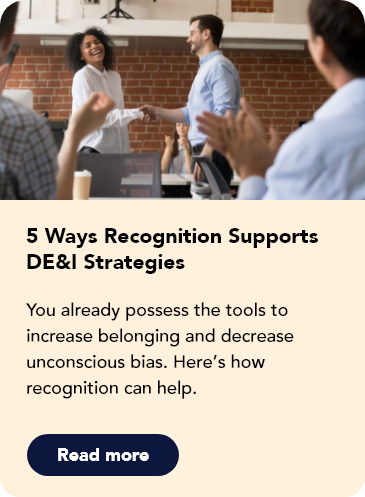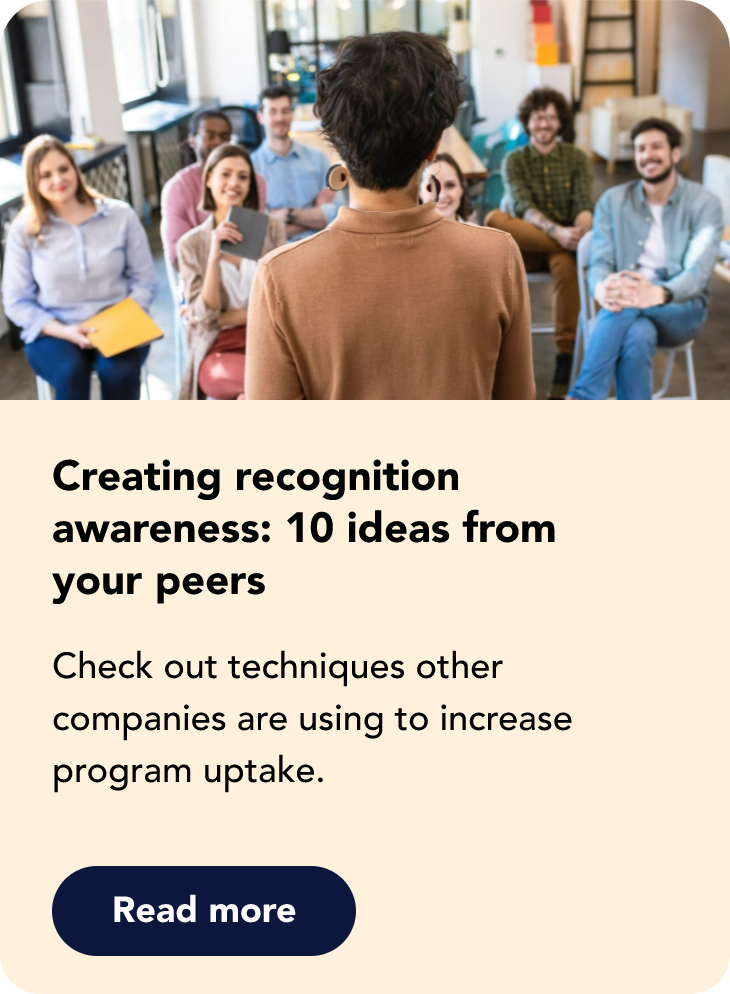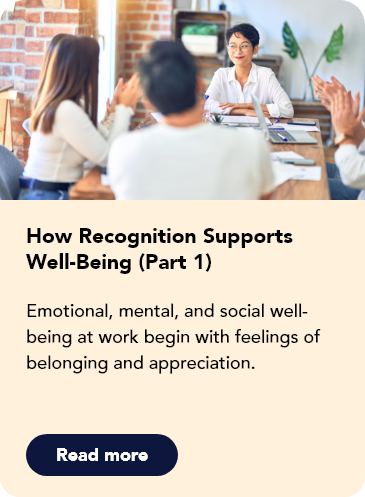Feelings of belonging and being valued can improve outcomes for occupational and physical well-being at work.

In the first part of our two-part series on well-being and recognition, we talked about how being appreciated for good work can help bolster social and mental well-being at work – leading to better outcomes around turnover, engagement, employee experience, and more.
In this post, we’ll look at how recognition and appreciation can help drive two other kinds of wellness: occupational and physical well-being. We’ll then round out this series with five tips on using Workhuman® as part of your broader employee wellness campaign.
Occupational Well-Being
Occupational well-being comprises job satisfaction and enrichment; equitable pay and financial resources; development, promotions and advancement; and safety. More than any other kind of well-being, it needs to be a top priority for you as cultural energizers.
This means creating a workplace where employees feel safe and supported. This begins with a work environment free of threat or hazard. It means establishing healthy levels of life-work balance. Fostering strong co-worker relationships and support networks will bolster belonging, purpose, and inclusion. And finally, you must provide workers with opportunities for personal career development, learning, and equitable career advancement.
Organizational benefits of high employee occupational well-being:
- Increased productivity and performance
- Fewer workplace accidents
- Lower levels of conflict and bullying
- Higher levels of equity and representation
- Reduced turnover and absenteeism
- More referrals and candidate attraction
- More diverse, creative teams with better problem-solving
- Better internal talent pipeline
How Workhuman helps
Most companies have legally mandated protections in place to ensure minimal occupational safety standards, but organizations can often do more to reduce risk and lower employee stress. Social Recognition® has proven to be a powerful tool for ensuring safety through positive reinforcement and rewards that encourage and model safe behavior throughout the organization.
Social Recognition is a key way to enable employees to support each other – improving inclusion and occupational well-being. Our celebrations products – Life Events®, Community Celebrations®, and Service Milestones® build on this strong foundation, cultivating group belonging and encouraging employees to bring their authentic selves into the workplace in a safe and affirming way.
Career well-being is also driven by employee development opportunities, strong employee feedback mechanisms, increased efforts at equity, and helping employees to better align with organizational goals. Conversations® provides a framework for this kind of talent development that can help ensure better alignment, encourage equitable advancement and long-term financial wellness, and build a strong pipeline of talent for future growth.
How recognition can help drive occupational well-being:
- Creates and reinforces relationships among co-workers
- Invites more equitable feedback and development
- Focuses attention on career development and learning
- Increases feelings of alignment and meaning in work
- Encourages and models safer workplace practices
- More equitably distributes material and financial rewards
- Invites employees to be themselves at work
- Helps identify top talent through social recognition
- Underscores successes with Service Milestones
Physical Well-Being
Physical well-being comprises employees’ bodily health and practices – such as nutrition, substance abuse, fitness levels, sleep, stress management, illness or pain management, and personal safety.
The benefits of a healthy workforce should be obvious for most organizations. Healthy workers will be more productive and less costly – which is hugely impactful on any bottom line. It follows that a failure to address low levels of physical well-being can lead to absenteeism, stress, injuries, accidents, disengagement, and higher voluntary turnover.
Many companies have long-standing programs for weight loss, quitting smoking, fitness, wellness education, and stress management. But if organizations want those programs to be successful, they must also focus on behavior – specifically on encouraging employees to participate in and invest effort in those programs.
- Organizational benefits of high employee physical well-being:
- Lower healthcare costs
- Reduced absenteeism and turnover
- Reduced accidents and injuries
- Higher productivity
- Greater sense of camaraderie and belonging
- Improved employee experience
How Workhuman helps
Your Social Recognition program helps employees feel included, reducing stress and improving support. It can also be a powerful way to influence employee uptake of programs and encourage safer, healthier behavior through positive reinforcement.
Life Events and Community Celebrations are also particularly powerful tools for physical well-being. By creating social connections, they help employees supported in their health journeys. You can use Life Events to recognize personal health milestones, like running a marathon, or successfully undergoing cancer treatment. Community Celebrations take this to a group level, supporting ERGs focused on wellness – such as meditation, fitness, diet, or smoking cessation groups.
The empowerment of these Workhuman tools has the side benefit of building confidence and belonging, encouraging workers to take part and take ownership over their own physical well-being.
How recognition can help drive physical well-being:
- Encourage healthier habits and practices
- Reward safe behavior and contributions to safety at work
- Reward safe behavior and contributions to safety at work
- Connect company health to your mission and values
- Encourage communities to coalesce around well-being and directly support ERGs
- Encourage communities to coalesce around well-being and directly support ERGs
- Celebrate major health milestones
- Community Celebrations support company- or employee-led challenges and initiatives
The Workhuman platform, at its heart, can be understood as a well-being platform – focused on bringing people together to support each other and make everyone’s well-being richer through appreciation.
Here are five next-level tips on using Workhuman as part of your broader employee wellness campaign – bolstering every kind of well-being.
5 Tips for Encouraging Well-Being Through Recognition
- Review your recognition program
Make well-being a central pillar of your culture by adding a new award reason that is focused more directly on employee efforts to boost well-being, peer support, or inclusion and belonging in your company. On a larger scale, incorporate your wellness program into a new program within your recognition platform to allow for increased visibility, support, and involvement.
- Educate ERGs
ERGs are instrumental in driving all kinds of well-being. Be sure to educate your ERG sponsors and members on how recognition can support their initiatives.
- Understand well-being with Moodtracker
Well-being can be tricky to understand and measure. Moodtracker® is a powerful tool to better understand if employees are feeling supported, safe, and healthy.
- Throw down the gauntlet
Create challenges around group wellness initiatives and recognize participants’ progress and participation. Use Community Celebrations to create a sleep challenge where employees focus on getting full sleep every night, a fitness challenge to track steps, or an initiative to help support cancer screenings.
- Focus on career well-being
Use your Social Recognition data to understand what’s happening across your organization. Track reward equity and identify career and occupational wellness opportunities by identifying and addressing outliers or high performers. Managers can play an integral part in tracking reward equity and supporting career and occupational wellness opportunities by identifying and addressing outliers or high performers through My Team reporting.
Be sure to check out the first part of this series to learn how recognition can help you to drive social and mental well-being in your organization! And reach out to your customer account team if you need guidance aligning Workhuman with your well-being strategy.


